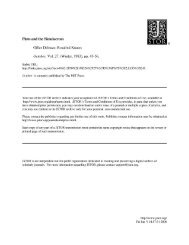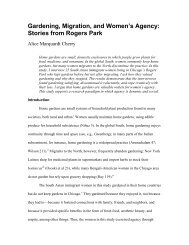research - Associated Student Government, Northwestern University
research - Associated Student Government, Northwestern University
research - Associated Student Government, Northwestern University
Create successful ePaper yourself
Turn your PDF publications into a flip-book with our unique Google optimized e-Paper software.
RESEARCHZaharoffone third of a child’s caloric intake in Cebu comes fromsnack foods prepared outside of the house (Adair et al.2005). In the CLHNS alone these effects can be seen.Among the mothers that began in the study in 1983, 6%were obese or overweight at the time while 35% wereobese or overweight in 1998 (Adair 2004). In 1996 30%of people in Cebu were suffering from chronic disease,a major sign of an area in a nutritional transition. Thenutritional transition is marked by increased incomes,consumer good, fatty foods and sedentary jobs alongwith a decrease in housework. These increased levelsof obesity and overweight people are concentrated inCebu, again pointing to the effects of urbanization(Adair 2004). The nutritional transition may be augmentingleptin levels in some way.The trends in leptin compared to anthropometricmeasures were consistent with the literature basedon western populations. Leptin correlated with BMI,Weight, Ticeps and Subscapular skinfolds, waist andhip circumference and WHR. The larger models,however, show that triceps skinfold and the measuresof subcutaneous fat account for the variation when allfactors (subcutaneous fat, visceral fat and body size)are taken into account. In males, waist circumference,hip circumference and WHR are still significant, butless significant than triceps and subscapular skinfolds.Therefore, in males visceral fat is a significant contributorto variation in leptin. Among measures of subcutaneousfat, in males’ triceps skinfolds is the best measurewith the highest t-value. Among females only tricepsskinfolds are significant when other measure of fat andsize are added to the model. Subcutaneous fat measuredthrough triceps skinfolds are obviously the strongestindicator of leptin in both sexes.While it was demonstrated that the population inthe Philippines is lean, they do not share traits withother lean populations. Both gender have strong correlationsbetween anthropometric measures and leptin,and subcutaneous fat has a very strong relationship withleptin in both males and females. The correlation in bothgenders was much weaker when the top 10% (based onBMI) was removed, reiterating the fact that leptin correlatesmost strongly at high adipose levels, this findingreflects previous data from lean populations.Observing leptin in lean populations, and seeing themechanism by its original intention will not be possiblein this population due to the high leptin levels. Furtherstudies should investigate why leptin levels in this populationare so high, and if leptin can be used as a negativefeedback loop to fight obesity.Literature CitedAbout the CLHNS — UNC Carolina Population Center. UNC Carolina Population Center. Web.06 Dec. 2011. .Adair, Linda S. 2004. Dramatic Rise in Overweight and Obesity in Adult Filipino Women andRisk of Hypertension. Obesity Research. 12.8.Adair, Linda S., and Barry M. Popkin. 2005. Are Child Eating Patterns Being TransformedGlobally? Obesity 13.7: 1281-299.Adair, Linda S., Popkin, Barry M. Akin, John S., Guilkey, David K., Gultiano S. ,Borja, J.,Perez, L., Kuzawa, CW., McDade T., and Hindin MJ. 2010. Cohort Profile: The CebuLongitudinal Health and Nutrition Survey. International Journal of Epidemiology 1.7:1-7.Banks WA, Phillips-Conroy JE, Jolly CJ, Morley JE. 2001. Serum leptin levels in wild andcaptive populations of baboons (papio): implications for the ancestral role of leptin. JClin Endocrinol Metab 86:4315–4320.Bribiescas, Richard G. 2001. Serum Leptin Levels and Anthropometric Correlates in AcheAmerindians of Eastern Paraguay. American Journal of Physical Anthropology 115.4:297-303.Clement K, Vaisse C, Lahlou N, Cabrolk S, Pelloux V, Cassuto D, Gourmelenk M, Dina C,Chambaz J, Lacorte J, Basdevant A, Bougne P, Lebouck Y, Froguel P, Guy-Grand B.1998. A mutation in the human leptin receptor gene causes obesity and pituitarydysfunction. Nature 392: 398-401.Cole TJM, Bellizzi MC, Flegal KM, Dietz WH. 2000. Establishing a standard definition for childoverweight and obesity worldwide: international survey. Br Med J 320:1240–1243.Considine RV, Sinha RK, Heiman ML, Kriauciunas A, Stephens TW, Nyce MR, OhannesianJP, Marco CC, McKee LJ, Bauer T, Caro J. 1996. Serum Immunoreactive-LeptinConcentrations in Normal Weight and Obese Humans. The New England Journal ofMedicine 5: 292-295.Dicker A, Ryden M, Naslund E, Muehlen IE, Wiren M, Lafontan M, Arner P. 2004. Effectof testosterone on lipolysis in human pre-adipocytes from different fat depots.Diabetologia 47:420– 428.FASTSTATS - Overweight Prevalence. Centers for Disease Control and Prevention. Office ofInformation Services, 17 Nov. 2011. Web. 05 Dec. 2011. .Gibson RS. 1990. Principals of Nutrition Assessment. Oxford <strong>University</strong> Press.Haffner, S. M. et al. 1996. Leptin Concentrations in Relation to Overall Adiposity andRegional Body Fat Distribution in Mexican Americans. International Journal of Obesityand Related Metabolic Disorders : Journal of the International Association for theStudy of Obesity 20: 904-08.Howard JK, Lord GM, Matarese G, Vendetti S, Ghatei MA, Ritter MA, Lechler RI, Lboom SR.1999. Leptin protects mice from starvation induced lymphoid atrophy and increasesthymic cellularity in ob/ob mice. J Clin Invest 104:1051–1059.Jequier E. 2002. Leptin signaling, adiposity, and energy balance. Ann N Y Acad Sci967:379–388.Kuzawa, C. W., E. A. Quinn, et al. 2007. Leptin in a lean population of Filipino adolescents.American Journal of Physical Anthropology. 132(4): 642-649.Lohman T, Roche A, Martorell R. 1988. Anthropometric Standardization Reference Manual.Champaign IL: Human Kinetics BooksMinocci A, Savia G, Lucantoni R, Berselli ME, Tagliaferi M, Calo G, Petroni ML, de Medici C,Viberti GC, Liuzzi A. 2000. Leptin plasma concentrations are dependent on body fatdistribution in obese patients. Int J Obes 24:1139–1144.Popkin BM., and Gordon-LarsenP. 2004. The nutrition transition: worldwide obesitydynamicsand their determinants. Int J Obes 28, S2–S9.Roemmich, James N. et al. 1998. Gender Differences in Leptin Levels during Puberty AreRelated to the Subcutaneous Fat Depot and Sex Steroids. Am J Physiol EndocrinolMetab 275: 543-51.Ruhle, Constance E, and James E. Everhart. 2001. Leptin Concentrations in the United States:Relations with Demographic and Anthropometric Measures. Am J Clin Nutr 74: 295-301.Sharrock K, Kuzawa CW, Leonard WR, Tanner S, Reyes-Garcia V, Vadez V, Huanca T, McdadeTW. 2008. Developmental Changes in the Relationship Between Leptin and AdiposityAmong Tsimane Children and Adolescents. American Journal of Human Biology 20:392-398.Shimizu H, Shimomura Y, Nakanishi Y, Futawatari T, Ohtani K, Sato N, Mori M. 1997. Estrogenincreases in vivo leptin production in rats and human subjects. J Endocrinol 154:285–292Staiger, H. Otto T. Jürgen M. Claus T. Andreas F. Elke Maerker, Fritz S., H. Michael S. 2003.Relationship of Serum Adiponectin and Leptin Concentrations with Body FatDistribution in Humans. Obesity 11.3: 368-76.Steven B. Heymsfield, M., M. Andrew S. Greenberg, et al. (1999). “Recombinant Leptin forWeight Loss in Obese and Lean Adults.” Journal American Medical Association 282: 8.Priya Sumithran, Luke A. Prendergast,Delbridge, E., Purcell, K., Shulkes A., Kriketos, A., and Proietto, J. 2011. Long-TermPersistence of Hormonal Adaptations to Weight Loss. The New England Journal ofMedicine 365:1597-604.Taylor, R. W. et al. 1998. Body Mass Index, Waist Girth, and Waist-to-hip Ratio as Indexesof Total and Regional Adiposity in Women: Evaluation Using Receiver OperatingCharacteristic Curves. Am J Clin Nutr 67: 44-49.Van Harmelen, V., S. Reynisdottir, P. Eriksson, A. Thorne, J. Hoffstedt, F. Lonnqvist, and P.Arner. 1998. Leptin Secretion from Subcutaneous and Visceral Adipose Tissue inWomen. Diabetes 47.6: 913-17.74 NORTHWESTERN UNDERGRADUATE RESEARCH JOURNAL











